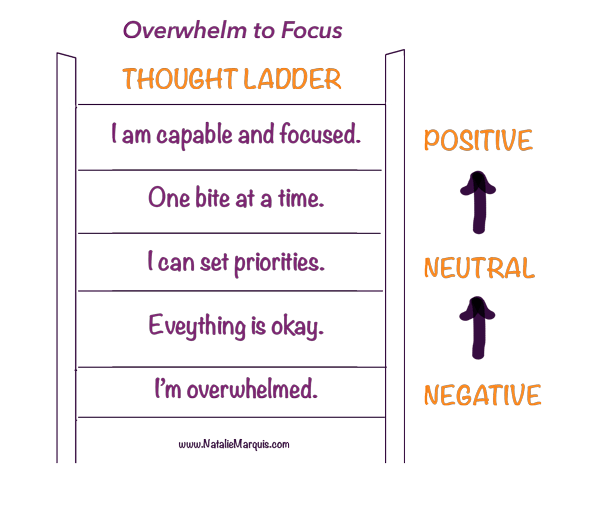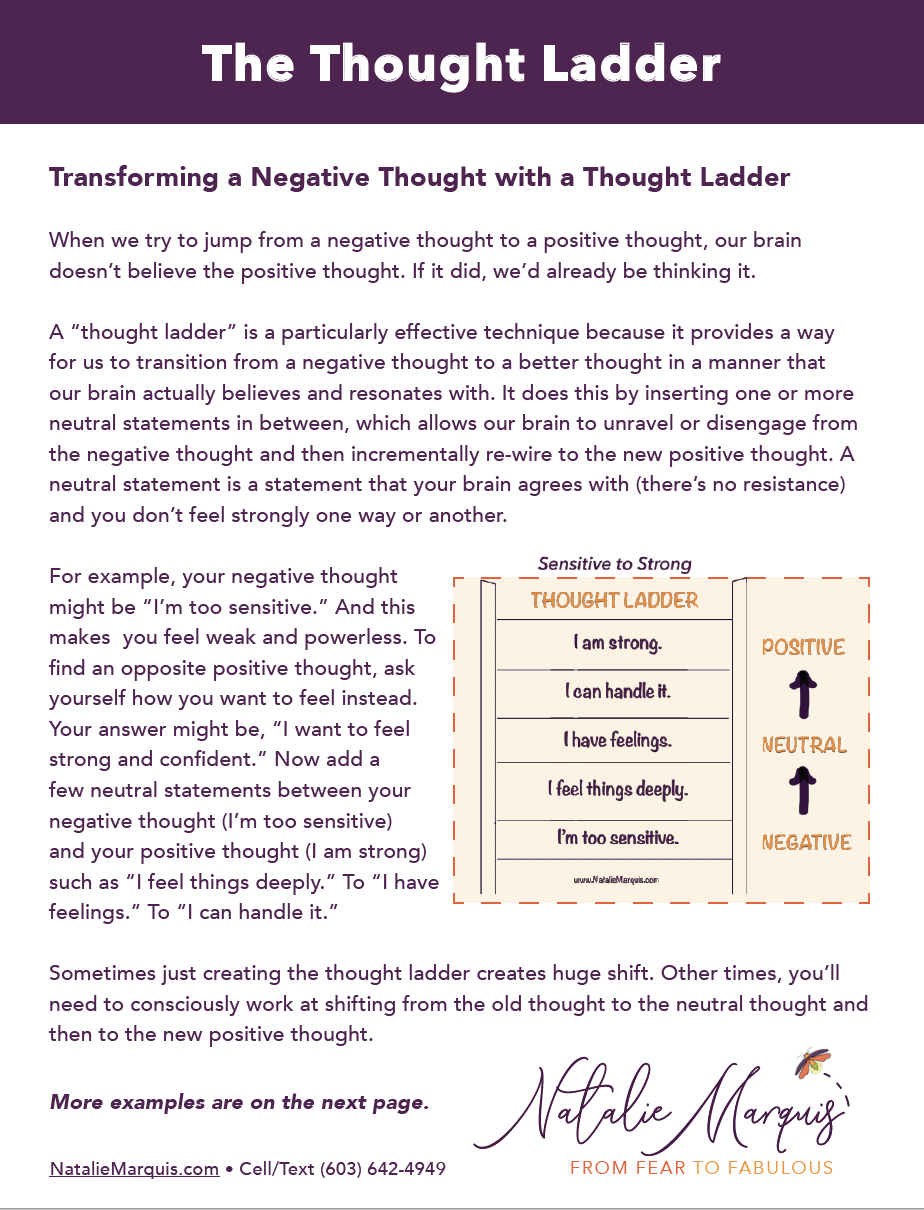How to Use a Thought Ladder to Shift Negative Thinking
Negative Thinking and the Thought Ladder
Yesterday morning it was a beautiful sunny day in Sedona, Arizona but my thoughts were dark and cloudy.
Every have one of those days? Yay, me too.
I didn’t like how I was feeling, which was sad and discouraged. The medicine I have my little cat Charlie seems to be losing its effectiveness. My little Charlie is an 18-month-old black and white Tuxedo cat. I rescued him when he was just 3 weeks old. His mama gave birth to him in an old abandoned barn that my former brother-in-law owned at the time. The Mama cat disappeared and never came back. I adopted Charlie, bottled fed him, and nurtured him back to life. I’ve had animals all my life and I’m big animal lover, but I think I’m extra close to Charlie because I bottled fed the little guy every hour on the hour for weeks in those early days. In any case, about 4 or 5 months go I discovered that Charlie has a neurological disease. I’d been hopeful that the medicine he is on would keep him feeling good and comfortable for at least a few years. But yesterday, I noticed he is laying down more, which is not typically young cat behavior and eating less. So I was feeling sad because there’s not much else I can do for the little guy. He has been such a joy and delight and I’m going to miss him so much when he’s gone.
I’ve learned not to stuff down or avoid my feelings, so I let myself grieve and feel sad. Usually being fully present with my feelings and allowing them to move through me works wonders. However, yesterday the sadness was heavy and lingering. As I was driving to work, still being present with what I was feelings, I realized that I was actually something deeper than sadness, I was feeling hopeless. As soon as I realized this I wanted to leap away from and resist being “hopeless” ….Hopeless felt it too dark and heavy. But I resisted that urge and let hopeless have some space. Once I did that, I realized that I was feeling hopeless because my thoughts weren’t saying “Charlie is going to die soon.” The thoughts running through my mind were also saying, “Everything is such a struggle. Nothing in my life is working out. This is too hard, I can’t do this. I have no one to hug me and tell me everything is going to be okay. I’ll never figure out a way to be happy again.” As you can see the thoughts were spiraling. None of them were true but it was what my brain was dishing out, so it’s no wonder I felt sad and hopeless.
If I didn’t do the work to pin point why I was feeling hopeless, I could have spiraled into feeling depressed for days. Instead, I allowed these emotions thoughts to roll through me, and once the energy of the emotion dissipated, I reminded myself that Charlie has had a wonderful life with me, I’ve been blessed to have him and I’m super grateful to have had in my life. I reminded myself that I can handle this – I can handle making sure he has quality of life for as long as possible and then making sure his transition is as smooth and loving as possible. And, I can reach out to my sister for emotional support and my friends for hugs when I need them.
Negative Thoughts and Negative Thinking
I want to share a specific technique I use to shift negative thinking. Now your negative thoughts might not be as dark was mine were yesterday. But we all have them, right? Your negative thoughts might sound like this:
- I’m not smart enough (motivated enough, pretty enough, strong enough, etc.)
- This is so overwhelming, I’ll never get everything done.
- Everything is so hard.
- It’s all my fault.
- Nobody loves me, nobody wants me.
- I’m too sensitive. I’m weak.
- If I say what I really think, people will leave me.
- I’m trapped.
- If I don’t do it perfectly then I’m worthless.
- All my co-workers think I’m stupid.
- I can’t handle this.
- I can’t trust or rely on other people.
80% of Our Thoughts Are Negative!
If you think thoughts like these, please know you’re not alone, and it’s not your fault. You heard me right; it’s not your fault! Did you know that according to the Cleveland Clinic, the average person has about 12,000 to 60,000 thoughts per day and about 80% of them are negative and a whopping 95% are repetitive thoughts? This means that most of these junky thoughts that cross your mind are based on old programming. This is good news because it means you can re-program your brain. It’s entirely within your power. It just takes practice and persistence.
Your Brain is a Computer
I like to use the analogy of computer when it comes the brain and how we think and feel. We were born into this world with our original divine programming. Our human soul “seed” included everything we needed to reach our highest potential. Just like the little acorn comes with everything it needs to become a big, beautiful, mighty oak, each of us came preloaded with everything we need to become our biggest, boldest, brightest selves.
When we consistently think the same negative thought over and over, it becomes a negative belief. Negative beliefs are like “virus” in our brain’s computer programming. A virus is a computer code that corrupts the system so it no longer runs smoothly or correctly. Likewise, our negative beliefs and thoughts are viruses that are making us think and feel like we are not good enough or that we’re somehow. This is not the truth of who we are and our true divine nature. Anytime we think or feel something crappy. It’s like a big flashing light letting us know we’re thinking and feeling something that is not in alignment with our true divine nature.
Negative Thinking is a Software Virus
Negative thinking can spread just like a virus creating negative thought patterns Once it becomes a negative thought pattern, it means that thought process has become a habituated. Once it becomes a habit the thought process typically goes unconscious and is stored in our subconscious, which means we are no longer aware of our negative thoughts or negative thought patterns. Just like a computer virus, we can’t see it but we feel and experience the negative effects of it everyday. This is why we often feel depressed, sad, anxious or frustrated but we don’t know why. It’s because the thought became a habit and is now hanging out in our subconscious. However, our feelings are clues that can help us find and pinpoint our negative thoughts and then consciously change them.
It does take some time and effort to do the self-coaching work necessary to change these negative thought patterns. If we don’t change these negative thought patterns the energy of the unresolved negative thoughts and emotion can stockpile in the body creating energetic blocks and leaks. Overtime these can create illness in the body, fatigue, anxiety, depression and more. The work I do, The Reiki Release Emotional Healing Method, helps pinpoint and release buried emotions and negative beliefs. Once that energy is release and once we are no longer consciously or unconsciously using our energy to stuff down old emotions and limiting beliefs we can then use this freed up energy to fuel our passions, goals and dreams. That’s why I love my work. It helps people let go of old pain and old programming so they can feel better and create a life they love to live.
Counseling, cognitive behavioral therapy, and hypnosis are also helpful resources. But there are also a lot of do-it-self methods we can use to find and release unprocessed emotions and transform our negative thinking. We can use affirmations, visualization, mantras, prayer, meditation and self-hypnosis. I’ve personally worked with them all and found them helpful but sometimes not as helpful as I hoped.
Shifting Negative Thinking with a Thought Ladder
I recently discovered that one of the reasons affirmations don’t always work is because we’re trying to pile positive thinking on top negative thinking, which energetically cancels itself out. We’re also quite often trying to jump from a negative thought to a super positive thought too quickly. This doesn’t work. Instead, we need to help our brains unravel or disengage from the negative belief. One way to do this is with a Thought Ladder. I first heard this term in podcast by Kara Loewentheil[1]. I’ll leave a link to her Thought Ladder episode in the show notes.
A thought ladder is a tool that enables us to transition from a negative thought to a positive thought by inserting one or more neutral statements in the middle. When we try to jump from a negative thought to a positive thought, our brain doesn’t believe the positive thought. If it did, we’d already be thinking it. A “thought ladder” is a particularly helpful technique because it helps us transition from a negative thought to a better thought ina way that our brain actually believes and resonates with. Having a series of neutral thoughts in the middle helps our brain unravel or disengage from the negative thought.
To create a thought ladder grab a blank piece of paper and a pen. Sketch a ladder by drawing two vertical lines a few inches a part. Next draw five horizontal lines evenly spaced between the two vertical lines. You now have a ladder. Now let’s suppose one of your negative thoughts is “I’m so overwhelmed.” Write down that negative thought on the bottom rung of your ladder. Next ask yourself, “How do I really want to feel?” Hmmm. I want to feel capable and focused. This is your positive statements, so write, “I am capable and focused” on the top rung of your ladder. Now, fill in the middle rungs with neutral statements. Neutral statements are statements or thoughts that your brain doesn’t feel either strongly negative or positive about. Neutral statements feel good in your body. They typically feel like a truth. When you say them, you easily believe. So to continue with the “overwhelm to capable” example, on the second rung I wrote, “Everything is okay.” On the middle rung I wrote, “I can set priorities.” On the forth rung, I wrote, “One bite at a time.” We have now created a thought ladder. In order, we have at the bottom:

Feel Your Feelings, then Shift the Thoughts
Sometimes just creating the thought ladder creates huge shift. Other times, you’ll need to consciously work at shifting from the old thought to the neutral thought and then to the new positive thought. Here’s how to do this. First begin by catching yourself thinking that negative thought. If you’re not aware of the particular thought, then notice what you’re feeling. Since all emotional feelings come from thoughts, we sometimes notice the feeling first. When it comes to overwhelm, we might feel anxiety in our belly or chest, or pressure in our head, or a heavy weight on our shoulders. Be with the feeling and the sensation of the feeling in your body. Let some of the energy of that feeling move through you rather than stuffing it down. Once you do this, you can now typically become aware of the thoughts you were thinking that are creating the feelings of overwhelm. You might notice you’re thinking, “I’ll never get all of this done.” “I have too much to do.” “I don’t have enough time.” “I don’t want to have to work so hard, I want to go outside and play.” It is thoughts like these that are creating the feeling of overwhelm.
Old Programing and Old Conditioning
At this point, it’s helpful to remind yourself that this thought is just old programming. We often think, “Well if I’m thinking it, it must be true.” This is definitely not true. Our brain was built to create thoughts. Like the heart pumps blood, our manufactures thoughts 24 hours a day, seven days of the week, and as I said earlier, most of the thoughts we think are junk (80% are negative and 95% are repetitive). You are the boss of your brain, so it’s time to start telling your brain what to think. So when you catch yourself thinking that negative thought, tell yourself that you are no longer owning that thought because it’s just old programming. And instead, affirm one of your neutral statements such as “In this moment everything is okay.” After repeating this a few times, you might feel ready to consider your next neutral though such as “I can set one or two priorities.” Let this thought, of setting one or two priorities, inspire you to take one small doable action. For example, you might begin by doing a brain dump of all your to-do items. List everything that you want to get done, no matter how small. You might need to write a 3-page article by Monday, clean the cat box, help Jessie with his science project, renew your car insurance, etc. From here you might choose your top priorities. Consider selecting your top three priories based on what you value most, maybe in this phase of your life it’s your career, family time, creating a peaceful and harmonious home environment, etc. Once you have your top three, pick one of the top three, and take concrete action to get that “to-do” item done.
Take Action on the New Thought
Taking action is super important. When we take action after choosing a neutral thought, it helps confirm to our brain, that we are truly thinking and moving in a new direction; one in which we feel capable and focused, which then makes it easier to affirm and embody “I am capable and focused.” Another tip is to look for and find evidence of your neutral and positive statements in you life. Ask yourself where else in my life is “Everything is okay”? This activates your brains reticular activity system, so rather than finding evidence of your negative thoughts, it seeks and finds confirmation of the new thought pattern. The more you do this the old negative thought pattern simply fades away.
Here are a couple of other thought ladder examples: I’m too sensitive. Being sensitive make me feel weak and powerless. So we ask ourselves how do we really want to feel instead? I want to feel strong and confident. A thought ladder for this might be “I’m too sensitive.” to “I feel things deeply.” To “I have feelings.” To “I can handle it.” And finally at the top: “I am strong.”
If you’re afraid of making mistakes, a helpful thought ladder might be: “Mistakes make me look bad.” To “Humans make mistakes” to “I am a human being.” To “I learn from my experiences.” And finally at the top: “I am wise and compassionate.”
And there you have it, a solid, concrete process for transforming negative thinking into empowered thinking. It’s a process that will help you begin taking back control of your brain and what it’s thinking. It’s the very process that I use myself. It works, but only if you work it. And I truly hope you’ll give it a try. And, please reach out if you have any questions or need some brainstorming assistance in finding neutral thoughts or creating a thought ladder for your particular issue. I’ll leave a link to a PDF of several Thought Ladder examples along with a fill in the blank Thought Ladder in the show notes so you can use it to transform your own thoughts. I’ll also include a link to Kara’s Thought Ladder episode. It is so worth doing the work to transform negative thinking, because when we think better, we feel better.
Namaste,

Episode Question to Ponder:
- When you think about your job or career what negative thoughts come to mind?
- When you think about your relationships what negative thoughts come to mind?
- When you think about health what negative thoughts come to mind?
- When you think about your finances what negative thoughts come to mind?
- How do you feel when you think these thoughts?
- How would you like to feel instead?
Free Download of Thought Ladder Examples and Worksheet
A super effective technique to help you take charge of what your brain thinks.
Episode References & Links:
- Our thoughts are 95% repetitive
- The Thought Ladder and Thinking v. Believing by Kara Loewentheil – PODCAST
- Thought Ladder by Kara Loewentheil – BLOG ARTICLE
Additional Resources
- Reiki Release Emotional Healing Method
- Hypnotherapy for Transforming Limiting Beliefs


